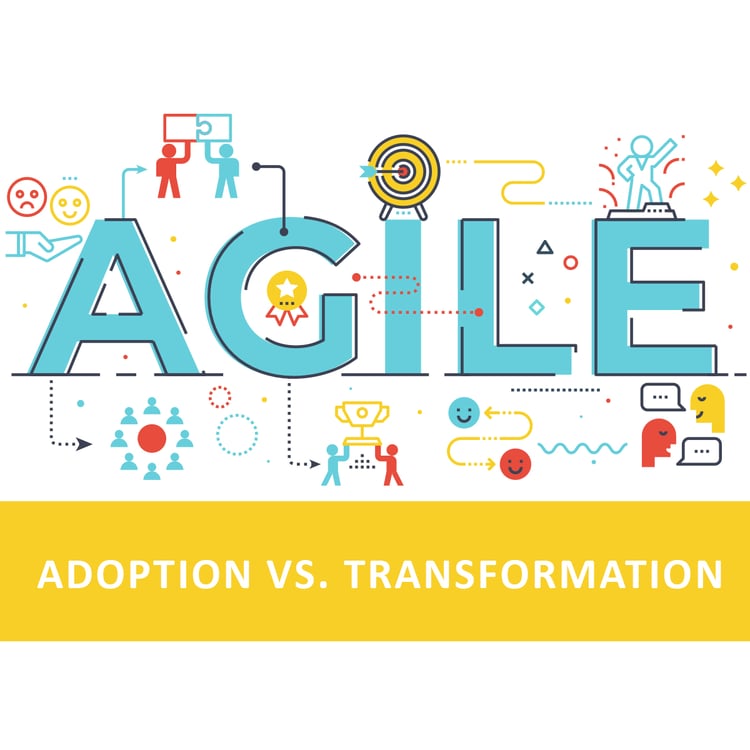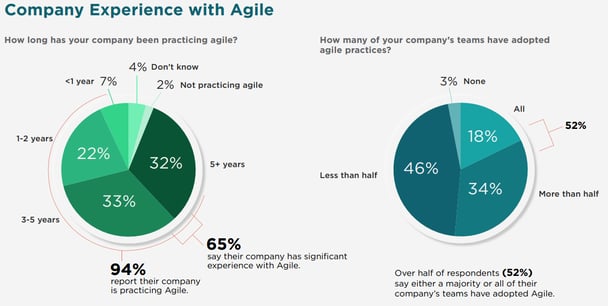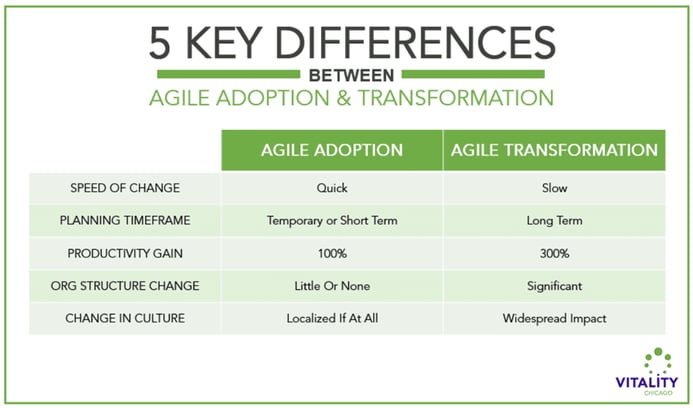
Over the past several years, I’ve worked with many organizations as an Agile Coach and Scrum Master. Through this experience, I’ve noticed there is often misunderstanding at varying levels within the organization around the difference between Agile Adoption and Agile Transformation.
My goal through this blog will be to share my thoughts around Adoption and Transformation and to articulate the basic differences.
First, let me start by defining what I mean by Adoption and Transformation. We find that many organizations think they are Agile when they adopt different Agile practices and begin to check these boxes daily, like having a Daily Standup, working in Sprints, or creating a Kanban board. Organizations may see some benefit in the early stages of a Transformation when Adoption is on the uptake; however, Adoption is just one of the factors that will help a Transformation be successful. A Transformation is about more than adopting a methodology and checking a box. A Transformation changes how the entire organization behaves; it changes the organization’s culture. This change may include aligning along value streams to create virtual teams focused on the same outcome delivery. And it should also involve getting business partners to engage with the IT delivery teams to provide regular input and feedback on the work. And Transformations may see new ways of budgeting around product delivery rather than project delivery. The bottom line is that an Agile transformation is about more than having teams adopt an Agile method.
Before we dive deeper into the differences between Agile Adoption and transformation, let me draw your attention to the 15th Annual State of Agile Report on company experience in practicing Agile.
The Annual State of Agile Report is the longest continuous annual survey of Agile techniques and practices as identified by over 1300 global respondents.

https://digital.ai/resource-center/analyst-reports/state-of-agile-report
Most of the respondents report their company has been practicing Agile. Quite clearly, Agile is the new buzzword, and corporations want to ensure that they don’t miss the bus. Many think it’s a plug-and-play kind of solution, and things improve overnight. It IS NOT!!
But what really is Agile Adoption, and how is it different from Agile Transformation?
In simple terms, Agile Adoption is changing the way a team does the work, whereas an Agile Transformation deals with changing the way an organization gets the work done. It’s about Doing Agile vs. Being Agile.
Sounds interesting?? Look at the 5 key differences as illustrated by Anthony Mersino.

- Speed of Change
Adoption can be quick and even measured in days or weeks. After a day or two of training, teams can agree on a tool, set up their board and events, and start following an Agile method like Scrum. I would refer to it as kind of a jumpstart. Transformations, on the other hand, can only be measured in years since the goal is about continuous improvement and cultural changes. In my previous blog, I defined the different levels and timelines as to when an organization can be transformed. While organizations might see Agile Adoption happen quickly, culture change across the organization is needed for a Transformation. And without question, culture change takes longer to come to fruition than team Adoption.
- Planning Timeframe
Agile Adoptions can be short—as the speed of change is quick compared to Transformations. Projects are temporary; thus, teams on projects can switch from Waterfall to Agile methodologies and be seen as adopting Agile. The planning timeframe for getting teams to adopt Agile can be short since we are simply changing how people work. Transformations, however, require long-standing and stable, Agile teams that take time to build. As you plan your Agile Transformation, the timeframe is much longer than that of simple Adoption, and it should include learning opportunities for everyone in the organization around the Agile mindset and how Agile organizations work differently. Change Management plays heavily in a Transformation plan.
- Productivity Gain
Researchers show a gain between 20% – 100% when it comes to Agile Adoption. In other words, just by teams following simple steps such as the PO setting priorities, focusing on a prioritized backlog, teams working together cross-functionally, etc., an organization will see gains in productivity. However, in a Transformation, one of the most significant benefits comes from developing T-shaped skills to become a cross-functional team. Transformation is more about empowering employees by encouraging them to be creative, understanding and accepting risks, and negating management layers allowing for more transparency. As an organization transforms, they decentralize decision making, advocate for innovation, focus on team outcomes over individual performance, engage business partners more readily, to name a few, and thus as a whole, may experience a productivity gain of close to 300%.
- Org Structure Change
Minimal-to-no structural change is required while a team adopts Agile methodologies. A Team of employees from different functional areas can come together to complete a project and may even move back to previous projects post completion. While together, they practice and adopt Agile methods. However, there can be chances of teams working in silos which can lead to significant inefficiencies. Team members reporting to different managers and having multiple hierarchies within a team can even delay decision-making.
Agile Transformation can have a significant impact on the organization. In a Transformation, the focus is on shifting from functional silos to more long-standing cross-functional stable teams, thereby reducing inefficiencies. While the reporting structure can remain matrixed, the team bond comes first in a Transformation. People managers in a Transformation shift their focus to employee enablement and engagement and less on directing daily work.
- Change in Culture
Have you ever heard the saying, “Culture eats strategy for breakfast?” As Adoption focuses on changing the way the team accomplishes work, a culture change may be seen solely within the group. One or more teams adopting Agile can lead to a Transformation, but it is unlikely to impact the culture significantly. When an organization sees the value from a team’s Adoption of Agile principles and practices, it may pave the way for a greater Transformation. I recommend engaging with a change management expert to help the organization’s culture change. This culture change is key to a Transformation and will bring customer satisfaction and respect for people.
In summary, both Agile Adoption and Transformations will bring value to your organization.
It all depends on the organization as to what path they follow; there isn’t a right or wrong here. I’m a strong believer that anything, when done the right way, will yield results. Its more about the process and believing in the process. What I think we can see here is that while organizations can derive value from an Agile Adoption, the true benefits come from the longer Agile Transformation.
What is the bottom line? Adoption is fast and easy, while Transformations take longer and require more planning and culture change, but without question, the benefits are worth it.
More from the blog
View All Blog PostsSubscribe to Our Blog
Fill out your email address to receive notifications about new blog posts from CC Pace!

